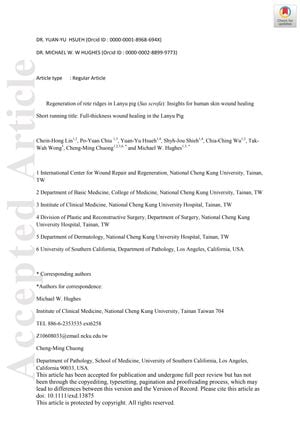TLDR Lanyu pigs show that partial-thickness wounds can partially regenerate important skin structures, which may help improve human skin healing.
The study examined the healing process of full-thickness (FT) and partial-thickness (PT) wounds in Lanyu pigs to understand human skin wound healing, focusing on the regeneration of rete ridges. Rete ridges are crucial for skin's mechanical function and are poorly regenerated after severe wounding. FT wounds led to significant scarring, absence of hair follicle neogenesis, and abnormal molecular and extracellular matrix changes, with no rete ridge formation. In contrast, PT wounds allowed for incomplete rete ridge regeneration and the reappearance of an alkaline phosphatase (ALP)+ cell population, which is associated with tissue regeneration. The study suggests that the preservation of this cell population may be key to preventing scarring and that the Lanyu pig is a relevant model for human skin due to similar skin architecture and cellular components. The findings highlight the importance of understanding rete ridge biology for developing regenerative therapies, although the number of pigs used in the study was not mentioned.
 19 citations
,
March 2018 in “Journal of Investigative Dermatology”
19 citations
,
March 2018 in “Journal of Investigative Dermatology” The gene Msx2 is crucial for hair follicle regeneration during wound healing.
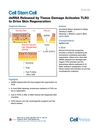 128 citations
,
August 2015 in “Cell Stem Cell”
128 citations
,
August 2015 in “Cell Stem Cell” Damage to skin releases dsRNA, which activates TLR3 and helps in skin and hair follicle regeneration.
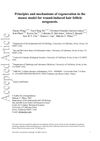 46 citations
,
March 2015 in “Regeneration”
46 citations
,
March 2015 in “Regeneration” Mice can grow new hair follicles after skin wounds through a process not involving existing hair stem cells, but requiring more research to understand fully.
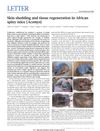 418 citations
,
September 2012 in “Nature”
418 citations
,
September 2012 in “Nature” African spiny mice can regenerate skin, hair, and cartilage, but not muscle, and their unique abilities could be useful for regenerative medicine.
 829 citations
,
May 2007 in “Nature”
829 citations
,
May 2007 in “Nature” Hair follicles can regrow in wounded adult mouse skin using a process like embryo development.
233 citations
,
October 2004 in “Differentiation” Stem cells are in deep skin layers, while differentiating cells are in shallow layers.
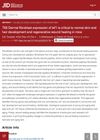 July 2022 in “Journal of Investigative Dermatology”
July 2022 in “Journal of Investigative Dermatology” Lef1 is essential for normal skin, hair growth, and healing wounds in mice.
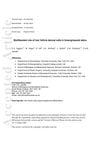 33 citations
,
September 2016 in “British journal of dermatology/British journal of dermatology, Supplement”
33 citations
,
September 2016 in “British journal of dermatology/British journal of dermatology, Supplement” Human hair follicle dermal cells can effectively replace other cells in engineered skin.
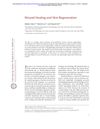 359 citations
,
January 2015 in “Cold Spring Harbor Perspectives in Medicine”
359 citations
,
January 2015 in “Cold Spring Harbor Perspectives in Medicine” Hair growth phase and certain genes can speed up wound healing, while an inflammatory mediator can slow down new hair growth after a wound. Understanding these factors can improve tissue regeneration during wound healing.
 1 citations
,
March 2011 in “Journal of Investigative Dermatology”
1 citations
,
March 2011 in “Journal of Investigative Dermatology” Blocking RANK signaling might help treat metastatic melanoma, but more research is needed.
January 2009 in “Junshi Yixue Kexueyuan yuankan” Hair follicle dermal sheath cells speed up skin wound healing.
